Introduction
Japanese tattoos—often referred to as irezumi—are one of the most iconic and culturally rich forms of body art. Known for their bold lines, vibrant colors, and deeply symbolic imagery, Japanese tattoos are more than just skin-deep. They tell stories of mythology, nature, honor, and personal identity, blending art and history in a way few other tattoo styles can.
From fierce dragons and protective tigers to elegant geishas and flowing cherry blossoms, every element in a Japanese tattoo carries meaning. These designs are traditionally large-scale—think full sleeves, back pieces, or even body suits—allowing each component to interact with the body’s natural form. Whether you’re drawn to the spiritual power of the koi fish or the fearsome strength of the oni (demon), Japanese tattoos offer both striking visuals and personal significance.
In recent years, Japanese tattooing has evolved to include both traditional and modern interpretations. Still, the respect for balance, symbolism, and storytelling remains central. If you’re considering this timeless style, you’re not just getting a tattoo—you’re wearing a piece of living art that speaks across generations.
How to Choose the Right Japanese Tattoo
Choosing the right Japanese tattoo involves more than selecting a cool design. Japanese tattoos are built on storytelling, symbolism, and cultural heritage. To find a tattoo that resonates with you personally and respectfully, consider the following:
1. Understand the Symbolism
Each image in Japanese tattooing has layers of meaning. For example:
- Koi Fish: Represents perseverance, transformation, and bravery.
- Dragons: Symbolize strength, wisdom, and protection.
- Cherry Blossoms (Sakura): Represent the fleeting nature of life.
- Tigers: Stand for courage and warding off evil spirits.
- Hannya Masks: Represent a jealous female demon, often symbolizing complex emotions.
Explore the meanings behind various motifs to align your tattoo with your personal values, beliefs, or life experiences.
2. Consider Cultural Respect
Japanese tattoos have a long, rich history and were once associated with samurai, folklore, and even the yakuza (organized crime groups). Today, they’re appreciated as an art form, but it’s still important to approach these designs with cultural awareness and respect. Avoid choosing symbols you don’t understand or using religious imagery superficially.
3. Choose the Right Artist
Japanese tattoos require specific technical skills—like smooth shading, consistent linework, and large-scale body flow. Seek an artist who specializes in irezumi or Japanese-style tattooing. Look through their portfolio to see if they stay true to the style and whether they incorporate both traditional and modern elements.
4. Plan the Composition
Japanese tattoos often flow like a painting across the body. Think beyond a single image—these tattoos are meant to tell a story. Talk with your artist about placement, layout, and how one element transitions into another. A good Japanese tattoo should look cohesive, not like separate stickers.
5. Personal Connection
Lastly, connect with the story you’re telling. Whether you relate to a koi fish’s resilience or want to honor someone through a cherry blossom, choose designs that hold lasting significance. Tattoos are permanent, and when tied to your narrative, they become even more meaningful.
Tattoo Placement Guide for Japanese Tattoos
Japanese tattoos are known for their dynamic flow across large areas of the body. Their placement is as important as the design itself because the art is meant to follow and enhance your body’s natural shape. Here’s how to approach placement:
1. Full Sleeves (Arm or Leg)
One of the most popular options for Japanese tattoos is the sleeve. Whether you choose a half-sleeve or a full-sleeve that connects into the chest or back, this placement allows for detailed storytelling. Artists often start with a central figure—like a dragon or koi—and build out with waves, wind bars, or flowers to fill the space.
2. Back Piece
Traditionally, Japanese tattoos covered the entire back and sometimes flowed down to the thighs. This expansive canvas is ideal for mythological scenes—like a samurai battle or a phoenix rising. A back piece offers a breathtaking visual and can accommodate years of additions or layers.
3. Chest and Shoulder
The chest and shoulder area is often used to complement a sleeve or back tattoo. Designs like Hannya masks, cranes, or peonies can sit over the chest and wrap into the armpit or upper arm. These placements are excellent for symmetry and bold impact.
4. Leg Sleeves
Lower-body tattoos are gaining popularity in Japanese tattooing. A leg sleeve provides a vertical space for dragons, snakes, waves, and floral elements. Like arm sleeves, they allow for excellent flow and movement.
5. Connecting Pieces
Japanese tattoos often work together as part of a larger story. For example, a koi fish on your arm can flow into a lotus flower on your chest and merge into a waterfall on your back. Talk to your artist about creating a design that builds cohesively over time.
Pro Tips:
- Symmetry and Balance: Make sure your tattoo flows naturally with your muscles and bone structure.
- Pain Consideration: The ribs, elbows, knees, and armpits are more painful. Plan your sessions accordingly.
- Future Expansion: Leave room if you plan to add more tattoos later. Japanese art often evolves across the body.
1. Koi Fish
The Koi Fish tattoo represents perseverance, strength, and transformation. In Japanese culture, koi fish are admired for their ability to swim upstream and overcome obstacles. This tattoo often features vibrant colors and intricate details, depicting the koi in various stages of movement.

It is a powerful symbol of personal growth and the journey toward achieving one’s goals, making it a popular choice for those who have faced challenges and emerged stronger.
2. Cherry Blossom (Sakura)
The Cherry Blossom tattoo symbolizes the fleeting nature of life and the beauty of transience. Cherry blossoms are celebrated in Japan for their short-lived but spectacular bloom, representing the delicate and ephemeral aspects of existence.
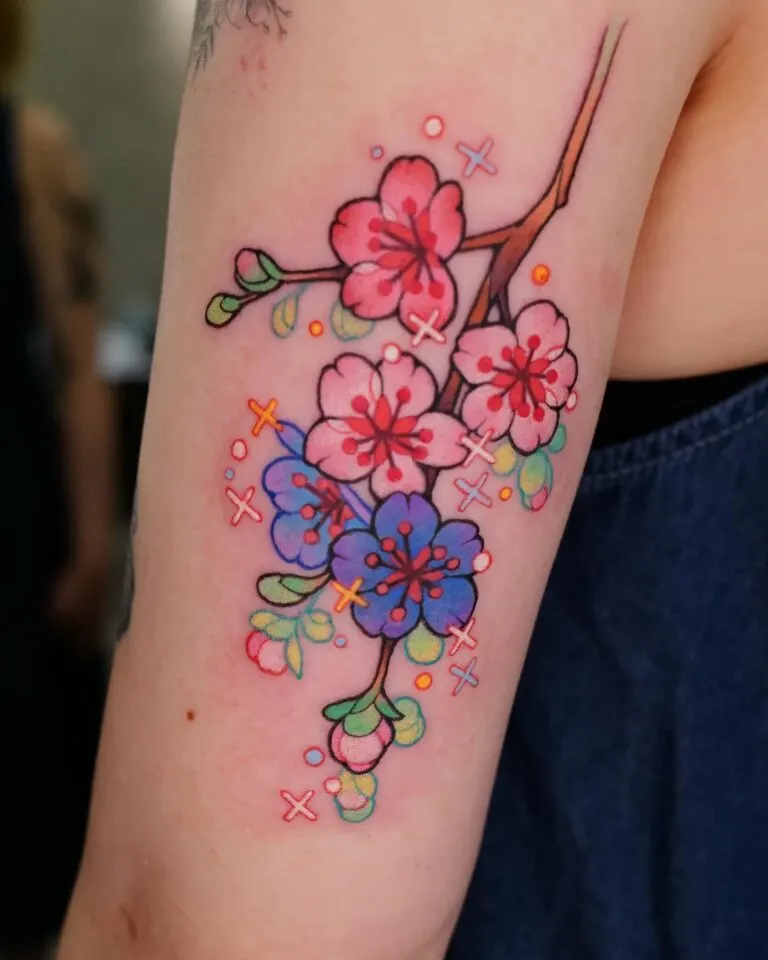
This tattoo often features clusters of pink blossoms and can be combined with other elements like falling petals or branches. It is ideal for those who appreciate the transient beauty of life and the reminder to cherish each moment.
3. Dragon
The Dragon tattoo is a symbol of power, wisdom, and protection in Japanese culture. Unlike the Western dragon, the Japanese dragon is often depicted as a benevolent creature with a serpentine body and clawed feet.
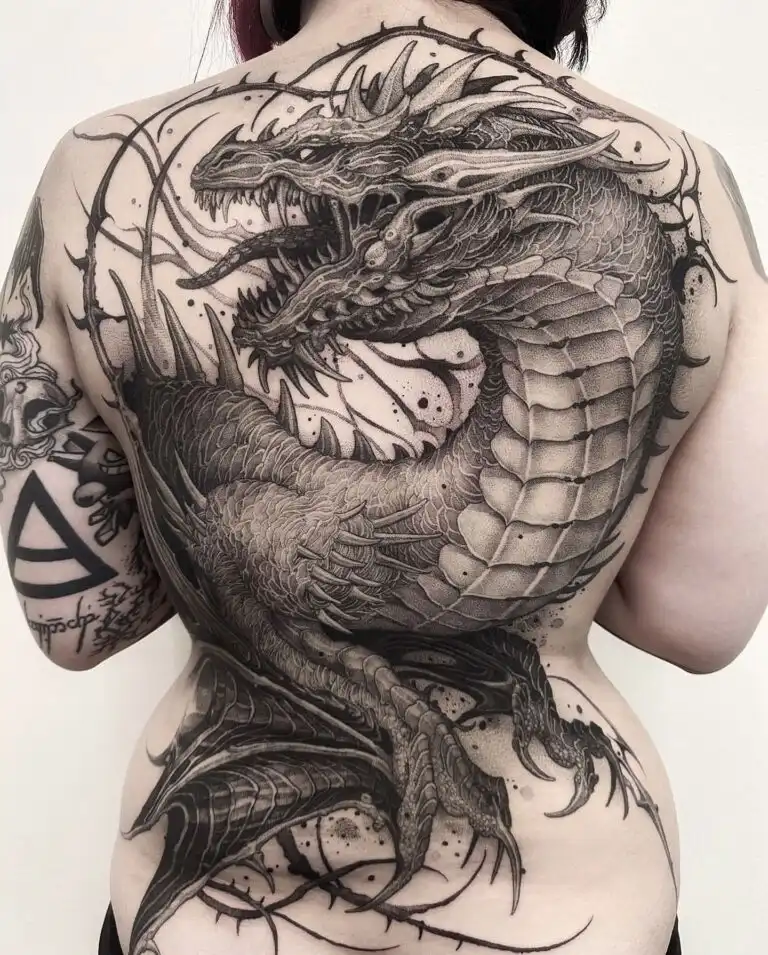
This tattoo can be highly detailed, featuring scales, clouds, and waves, and is often associated with good fortune and strength. It’s a popular choice for those who want to embody the dragon’s noble qualities and seek guidance and protection.
4. Tiger
The Tiger tattoo represents courage, strength, and protection. In Japanese culture, tigers are seen as powerful and fearless creatures that ward off evil spirits. This tattoo often features a dynamic and fierce depiction of the tiger, with bold colors and intricate details.
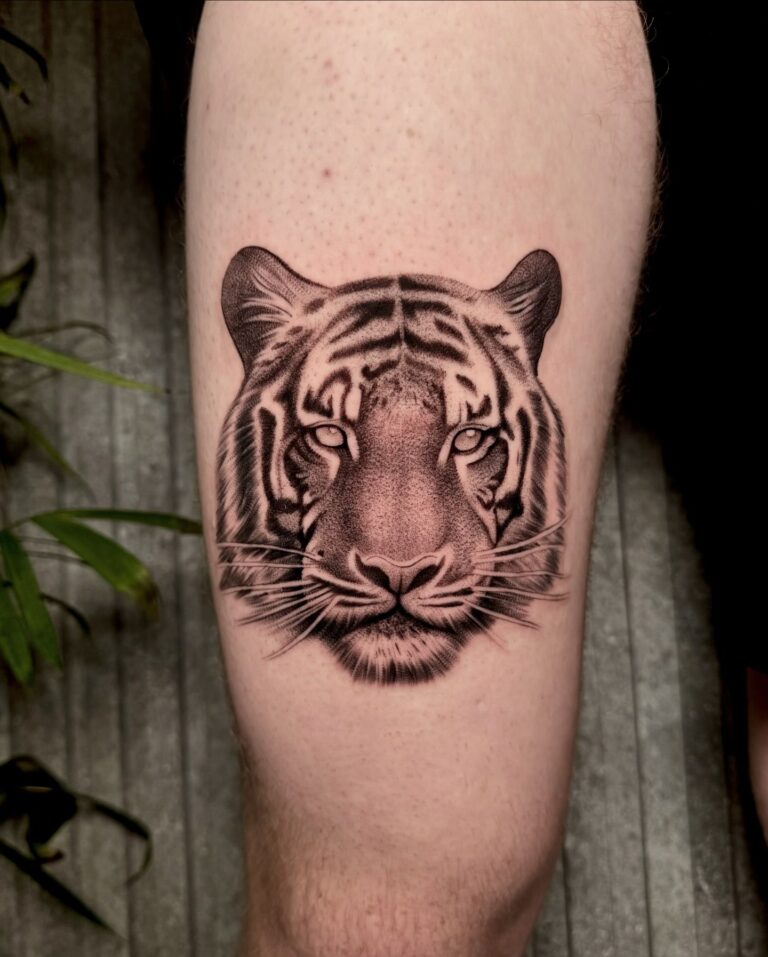
It is perfect for those who want to symbolize their inner strength and bravery or who feel a deep connection to the tiger’s majestic and commanding presence.
5. Geisha
The Geisha tattoo represents grace, beauty, and tradition. Geishas are skilled performers who embody the art and culture of Japan, and their tattoos often depict them in elaborate kimonos with traditional hairstyles.
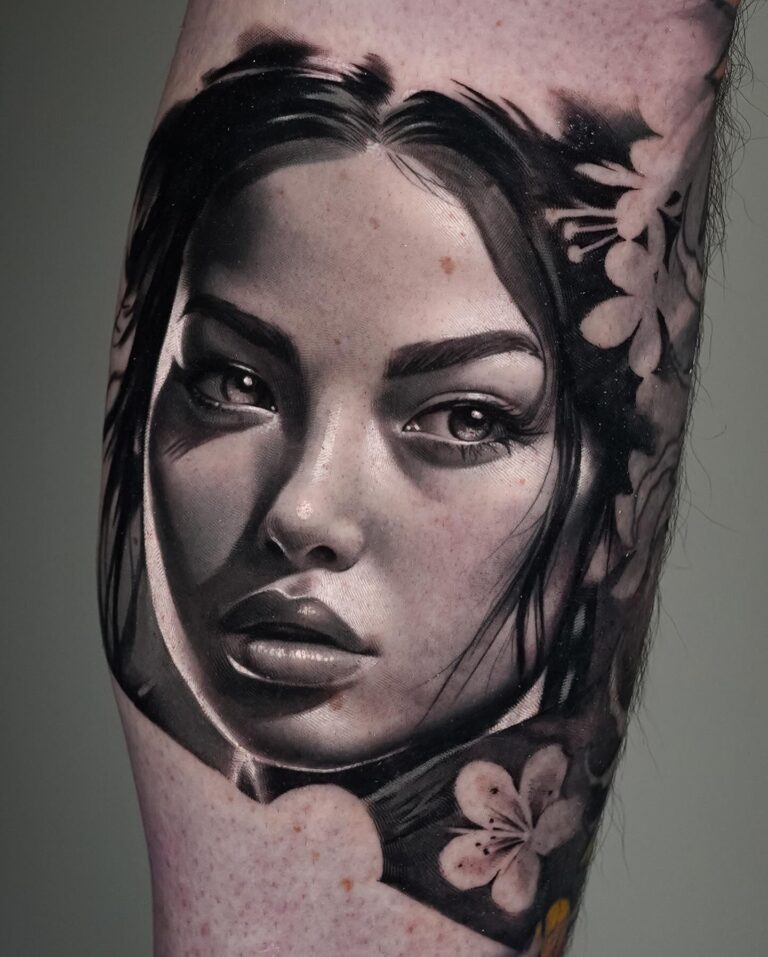
This tattoo can be detailed, showcasing the intricate designs of the kimono and the elegance of the geisha’s demeanor. It’s ideal for those who appreciate Japanese culture and want to honor its rich artistic traditions.
6. Samurai
The Samurai tattoo symbolizes honor, discipline, and warrior spirit. Depicting the legendary Japanese warriors, this tattoo often features a samurai in full armor, ready for battle.
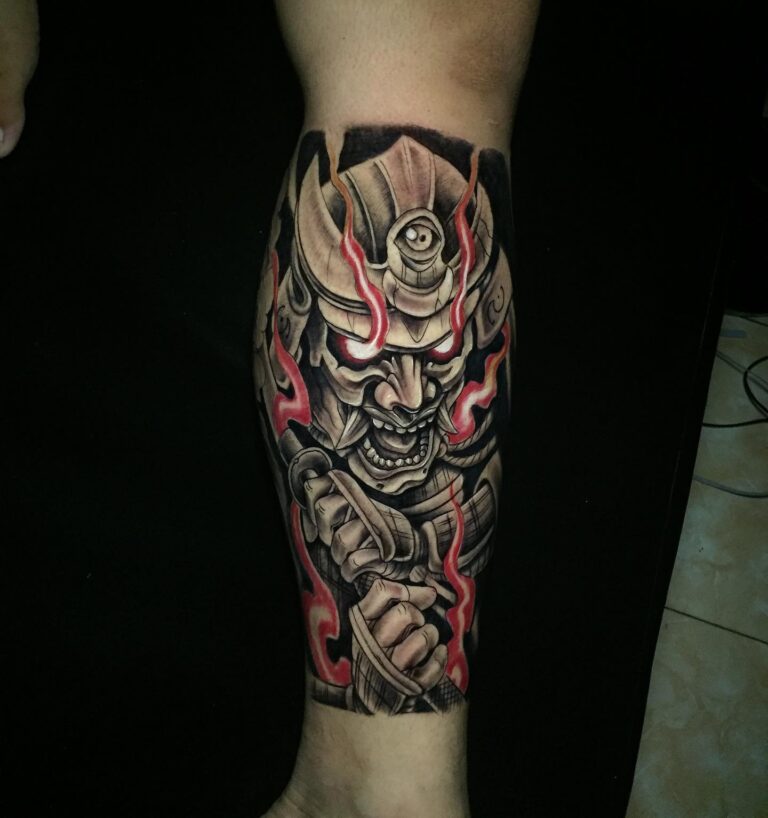
It can include elements like swords, cherry blossoms, or intricate armor designs. This tattoo is perfect for those who admire the samurai code of bushido and wish to embody the principles of bravery, loyalty, and strength.
7. Hannya Mask
The Hannya Mask tattoo represents the dual nature of emotions, particularly anger and jealousy. In Japanese Noh theater, the Hannya mask is used to depict a woman transformed into a vengeful spirit.
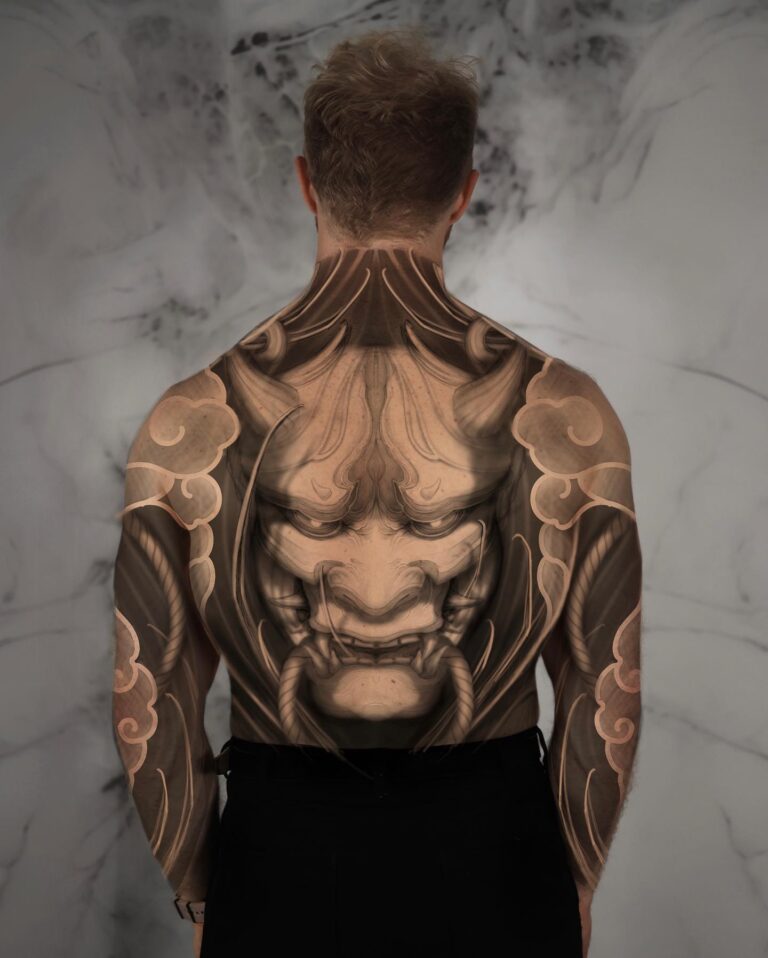
This tattoo is often highly detailed, featuring the mask’s fierce expression and sharp horns. It’s ideal for those who want to explore themes of transformation and the complexities of human emotions, or who appreciate the dramatic and artistic aspects of Japanese theater.
8. Wave (The Great Wave)
Inspired by Hokusai’s famous woodblock print, The Great Wave tattoo represents the power and beauty of nature.
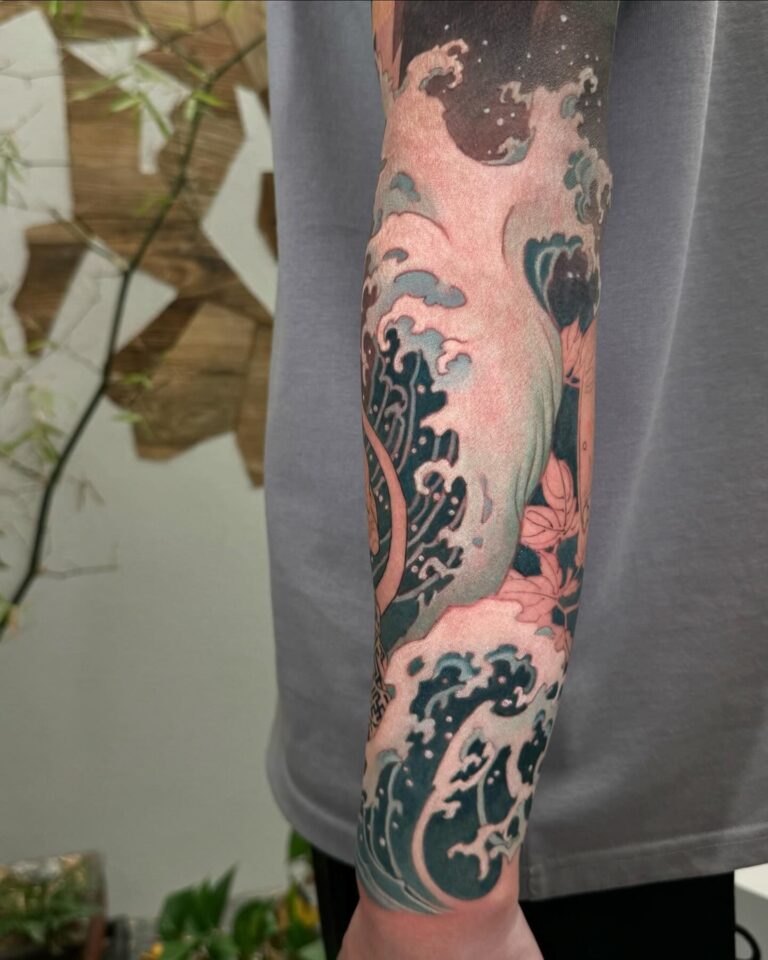
This tattoo often features a large, crashing wave with intricate details, capturing the dynamic and awe-inspiring force of the sea. It’s a popular choice for those who admire the natural world and want to symbolize the strength and majesty of the ocean.
9. Phoenix
The Phoenix tattoo symbolizes rebirth, immortality, and renewal. In Japanese culture, the phoenix, or “Ho-oh,” is a mythological bird that represents the cyclical nature of life and the triumph over adversity.
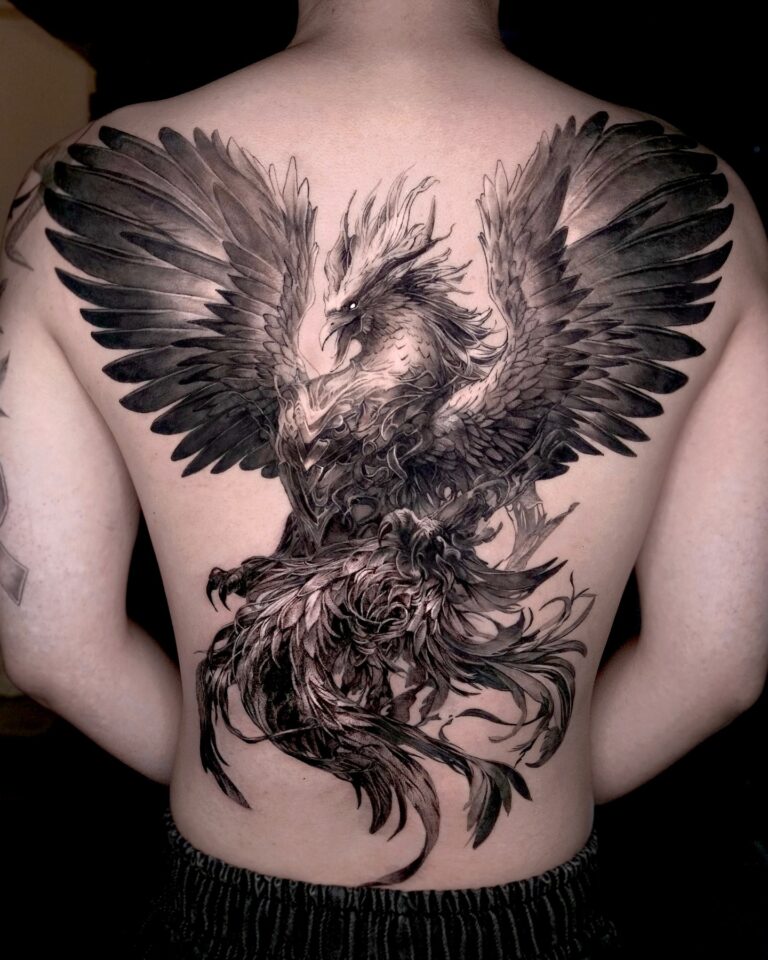
This tattoo often features vibrant colors and elaborate feather details, capturing the majestic and fiery essence of the phoenix. It’s ideal for those who have undergone significant personal transformation and want to celebrate their resilience and growth.
10. Bamboo
The Bamboo tattoo symbolizes resilience, flexibility, and strength. Bamboo is known for its ability to bend without breaking, making it a powerful symbol of endurance and adaptability.

This tattoo often features tall bamboo stalks with delicate leaves, creating a simple yet elegant design. It’s perfect for those who value strength in the face of adversity and appreciate the natural beauty of bamboo.
11. Waves and Koi
Combining waves with koi fish, this tattoo represents harmony between the forces of nature and personal perseverance. The koi fish, swimming through turbulent waves, symbolizes overcoming challenges and the ability to navigate life’s ups and downs.
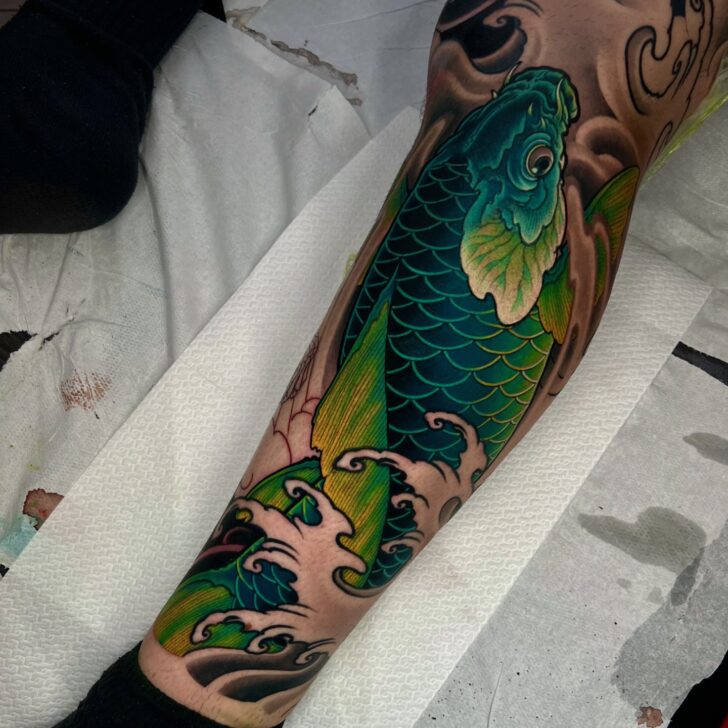
This design often features dynamic and flowing lines, capturing the movement of both the water and the fish. It’s ideal for those who want to express their resilience and adaptability in the face of life’s challenges.
12. Tengu
The Tengu tattoo represents protection, strength, and the supernatural. In Japanese folklore, tengu are mythical creatures known for their martial prowess and spiritual power.
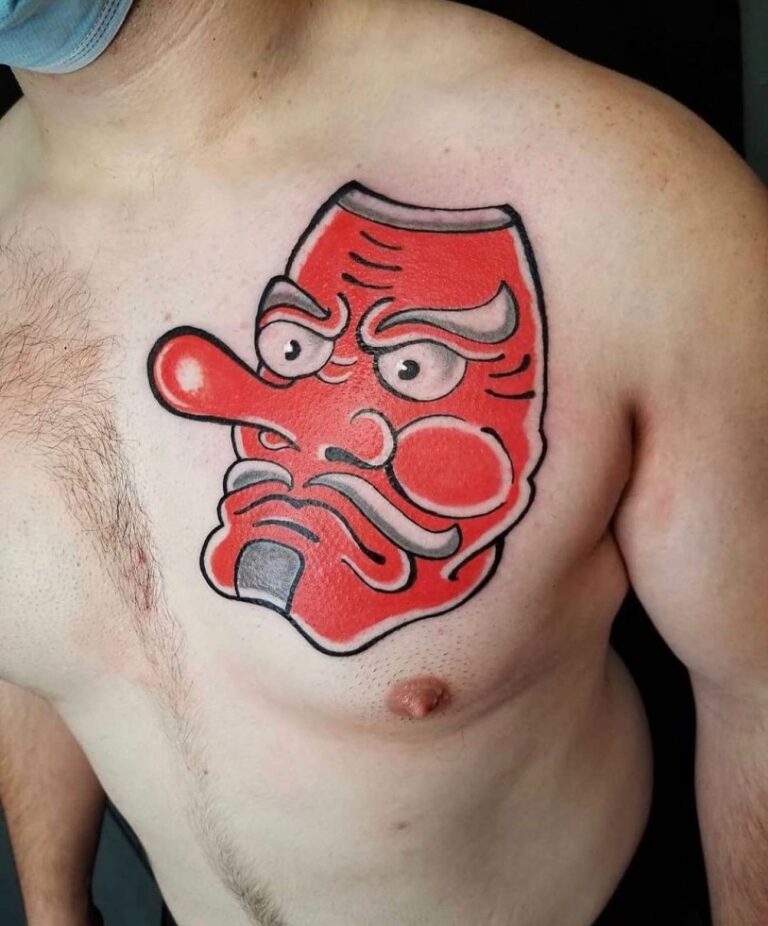
This tattoo often depicts the tengu with a long nose, red face, and traditional clothing, sometimes holding a staff or sword. It’s a popular choice for those who want to symbolize their connection to the mystical and protective aspects of Japanese mythology.
13. Uroko (Scale Pattern)
The Uroko tattoo features a pattern of overlapping scales, symbolizing protection and transformation. This traditional Japanese motif is often used in tattoos to represent the scales of a fish or dragon.
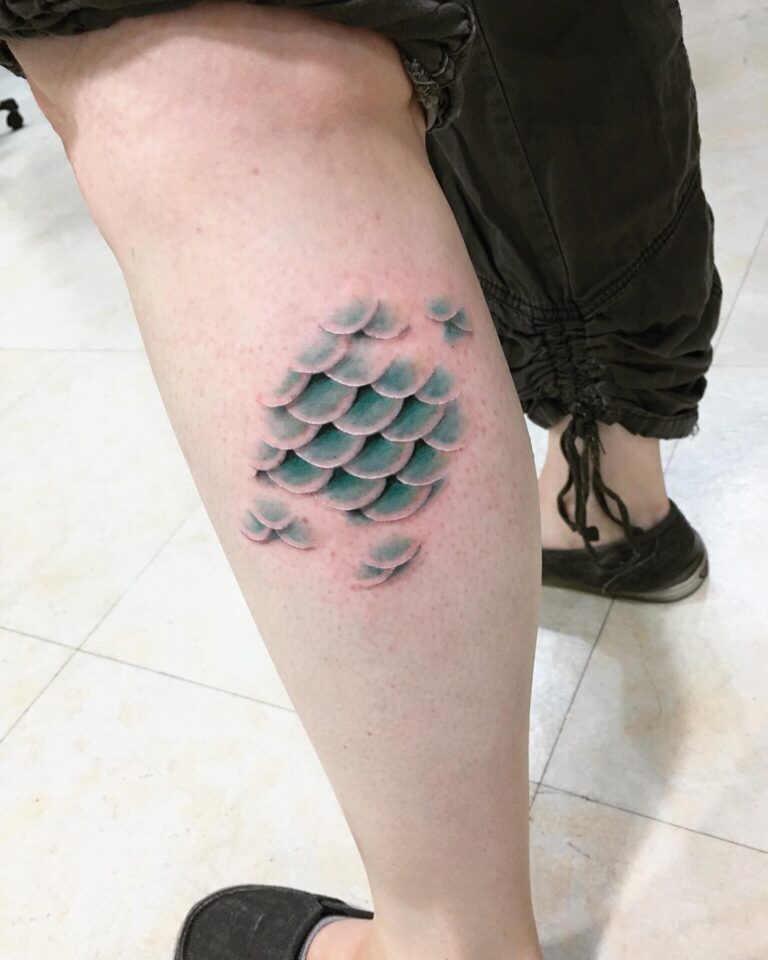
The design can be intricate or simple, covering large areas of the body or focusing on smaller details. It’s ideal for those who want a tattoo that conveys a sense of strength and defense.
14. Crane
The Crane tattoo represents longevity, peace, and good fortune. In Japanese culture, cranes are revered as symbols of a long and happy life, often associated with wisdom and grace.

This tattoo often features a crane in flight or perched gracefully, with detailed feathers and an elegant posture. It’s perfect for those who seek to embody the crane’s qualities of serenity and the hope for a prosperous future.
15. Lotus Flower
The Lotus Flower tattoo symbolizes purity, enlightenment, and rebirth. In Japanese culture, the lotus represents spiritual awakening and the ability to rise above challenges.
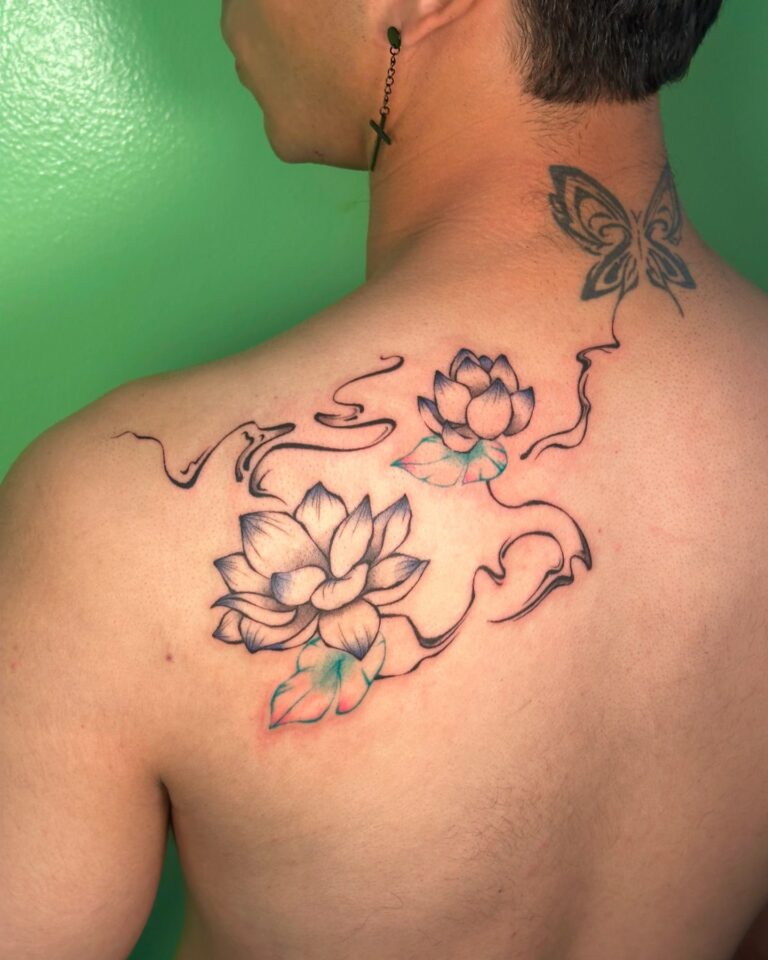
This tattoo often features a blooming lotus with delicate petals and vibrant colors, capturing its beauty and significance. It’s ideal for those who want to express their journey toward spiritual growth and transformation.
16. Yin and Yang
The Yin and Yang tattoo represents balance, harmony, and the interconnectedness of opposing forces. This ancient symbol illustrates how seemingly opposite elements are interconnected and complementary.
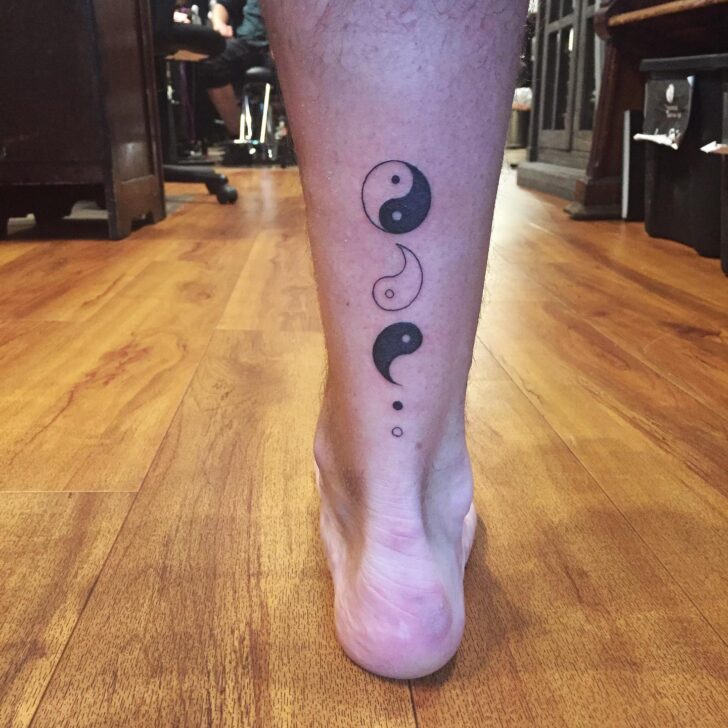
The tattoo often features the classic black and white swirl with dots, symbolizing the balance between light and dark, good and evil. It’s perfect for those who value equilibrium and the idea of balance in their lives.
17. Shōryū (Blue Dragon)
The Shōryū, or Blue Dragon, tattoo symbolizes wisdom, protection, and good fortune. In Japanese mythology, blue dragons are considered auspicious and powerful, often associated with water and the heavens.

This tattoo features a majestic blue dragon, often depicted with flowing mane and intricate scales. It’s perfect for those who want to embody the dragon’s strength and the positive attributes associated with its mythical presence.
18. Hokusai’s Waves
Inspired by Hokusai’s woodblock prints, this tattoo features the iconic wave patterns from “The Great Wave Off Kanagawa.” The design captures the movement and force of the ocean, emphasizing the beauty and power of nature.
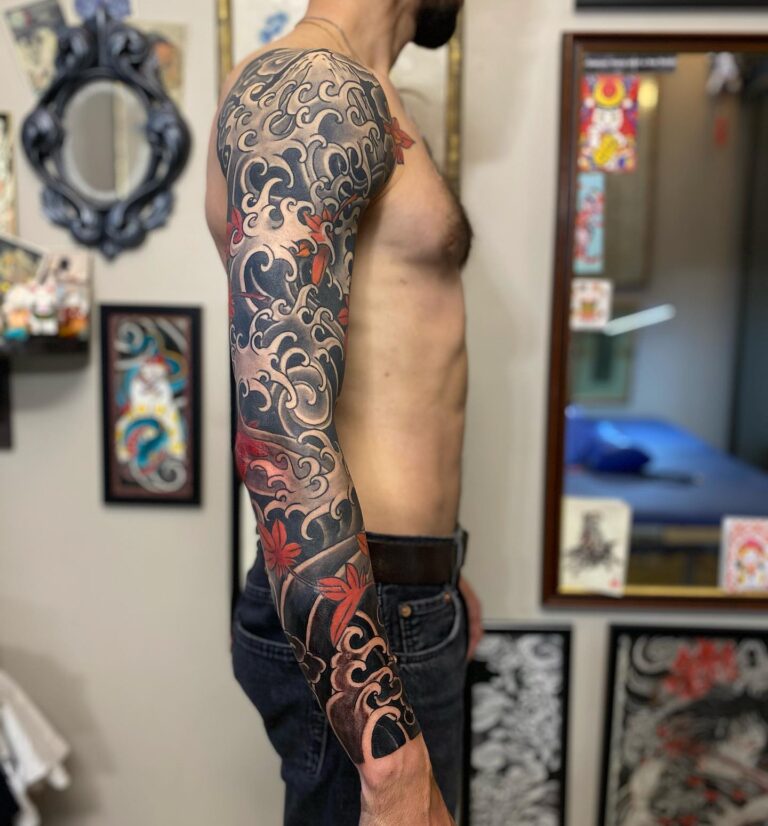
The tattoo can be detailed and dynamic, often covering larger areas of the body. It’s ideal for those who appreciate classic Japanese art and want to symbolize the grandeur and unpredictability of the sea.
19. Irezumi (Traditional Japanese Tattoo)
The Irezumi tattoo is a traditional Japanese style known for its bold colors, detailed patterns, and symbolic imagery. Irezumi often includes elements like koi fish, dragons, and waves, blending them into a cohesive and intricate design.
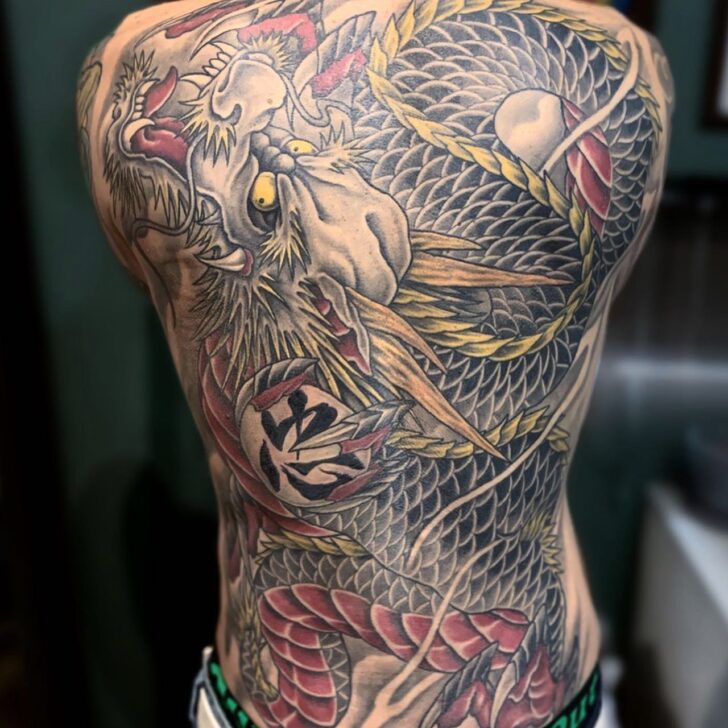
This tattoo style is ideal for those who appreciate the rich history and artistry of traditional Japanese tattoos and want to honor this cultural heritage with a striking and elaborate piece.
20. Japanese Oni Mask
The Oni Mask tattoo represents demons or ogres in Japanese folklore, symbolizing strength, protection, and the struggle against evil. Oni masks are known for their fearsome appearance and are often used to ward off negative influences.
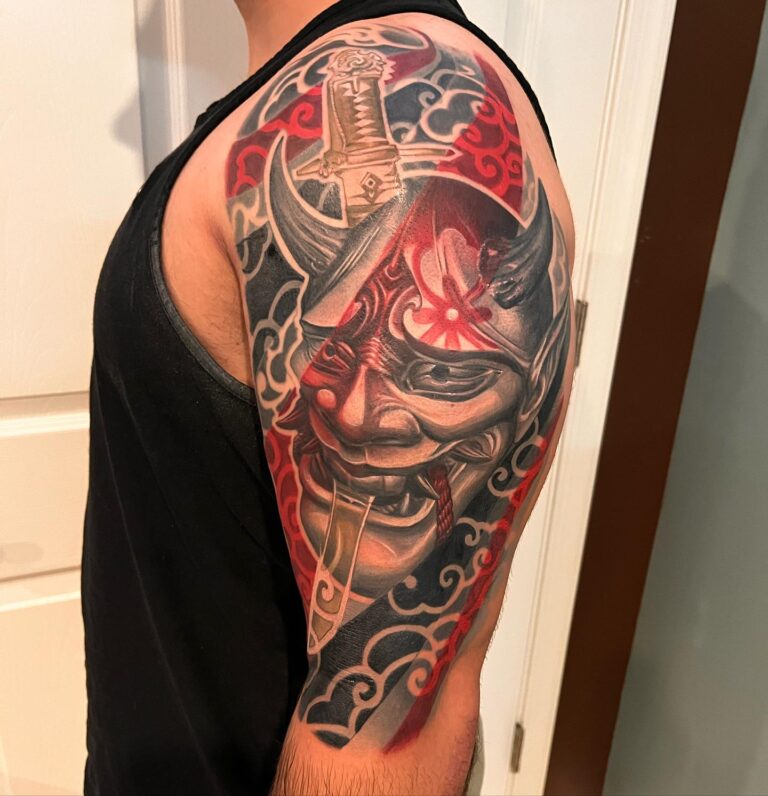
This tattoo can be highly detailed, featuring the mask’s sharp teeth, horns, and fierce expression. It’s perfect for those who want to embody the power and protective qualities of these mythical creatures.
21. Fūrin (Wind Chime)
The Fūrin tattoo features traditional Japanese wind chimes, which symbolize summer, tranquility, and the gentle flow of time. The design often includes a delicate bell with flowing ribbons, capturing the serene and calming nature of the wind chime’s sound.
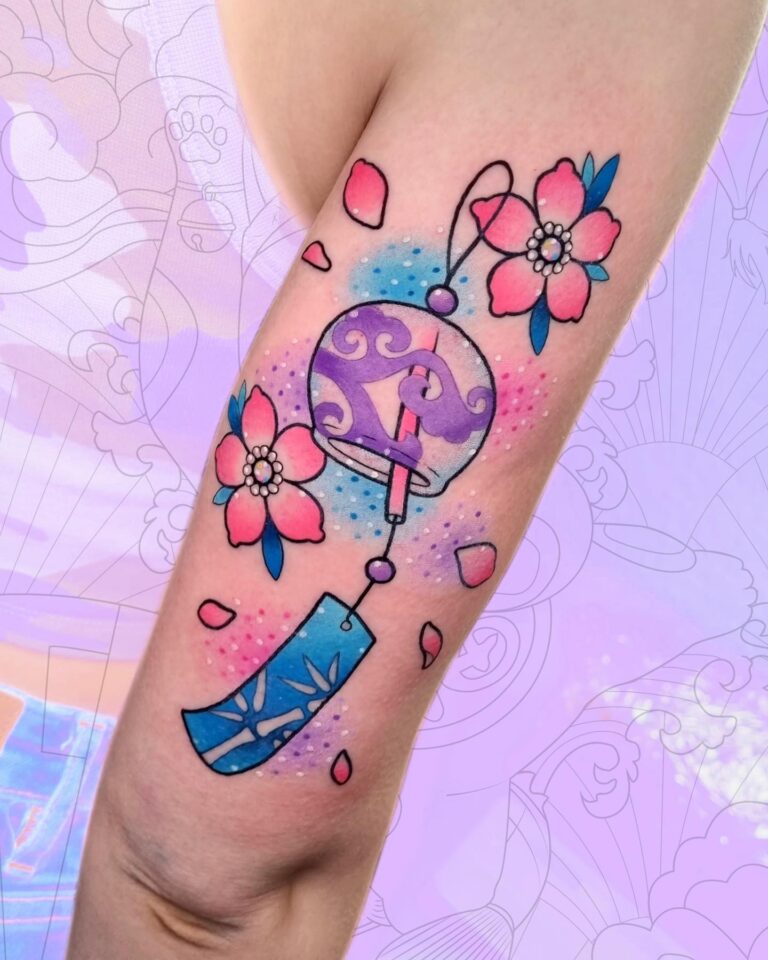
This tattoo is ideal for those who appreciate the subtle beauty of traditional Japanese elements and want to express a sense of peace and tranquility.
22. Matsu (Pine Tree)
The Matsu tattoo features the pine tree, symbolizing longevity, resilience, and endurance. Pine trees are revered in Japanese culture for their ability to thrive in harsh conditions and their association with eternal life.
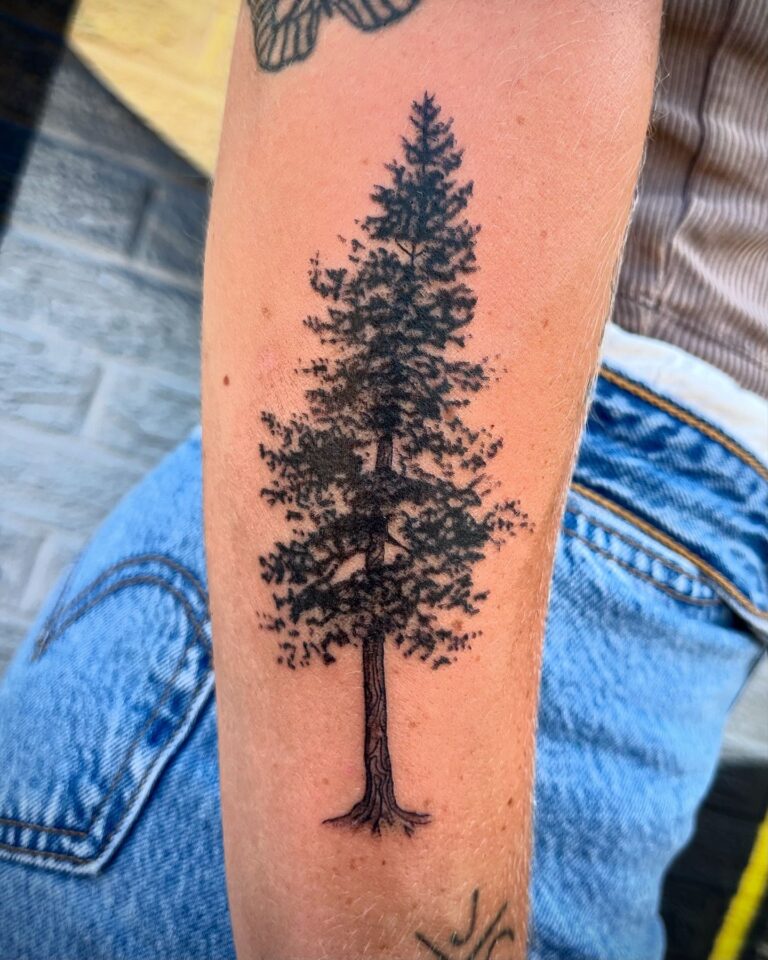
This tattoo often depicts a detailed pine tree with branches and needles, creating a design that conveys strength and perseverance. It ’s perfect for those who value the qualities of resilience and the enduring nature of the pine tree.
elatialoamtattooandclaw_and_talon_tattoo
23. Maneki Neko (Lucky Cat)
The Maneki Neko, or Lucky Cat, tattoo symbolizes good fortune, prosperity, and protection. This iconic Japanese figure, often depicted with one paw raised, is believed to attract positive energy and bring good luck.
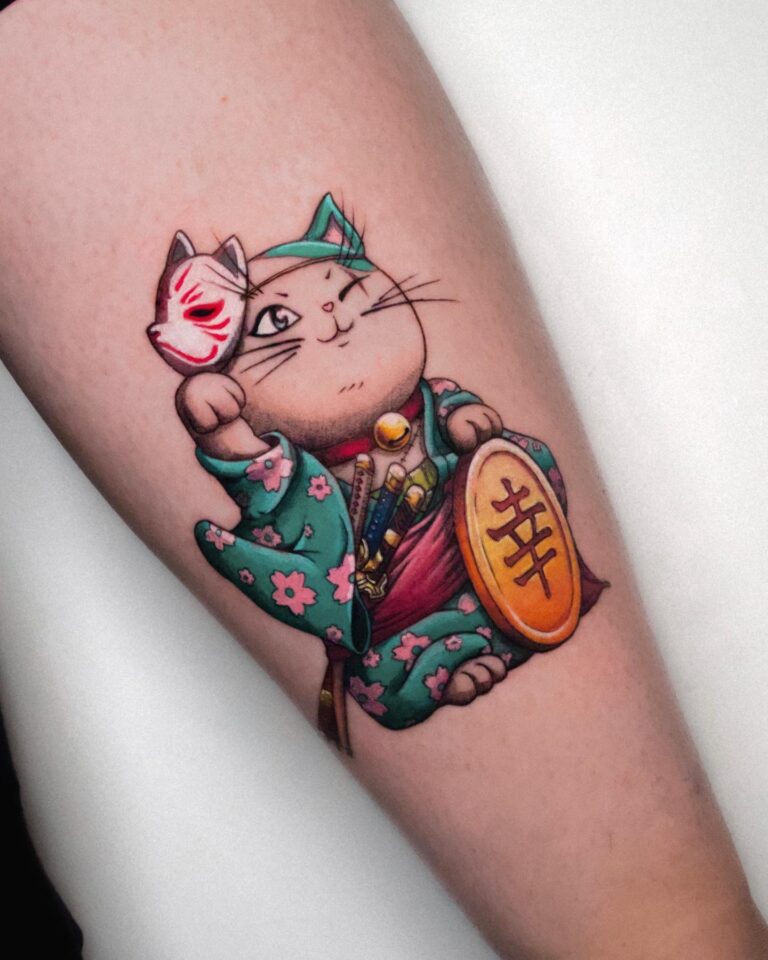
The tattoo can be colorful and playful, featuring the cat in various poses and with traditional accessories like a koban coin. It’s ideal for those who want to invite prosperity and good vibes into their lives.
24. Japanese Chrysanthemum
The Chrysanthemum tattoo represents longevity, rejuvenation, and the beauty of life. In Japanese culture, chrysanthemums are associated with the fall season and are admired for their resilience and vibrant colors.
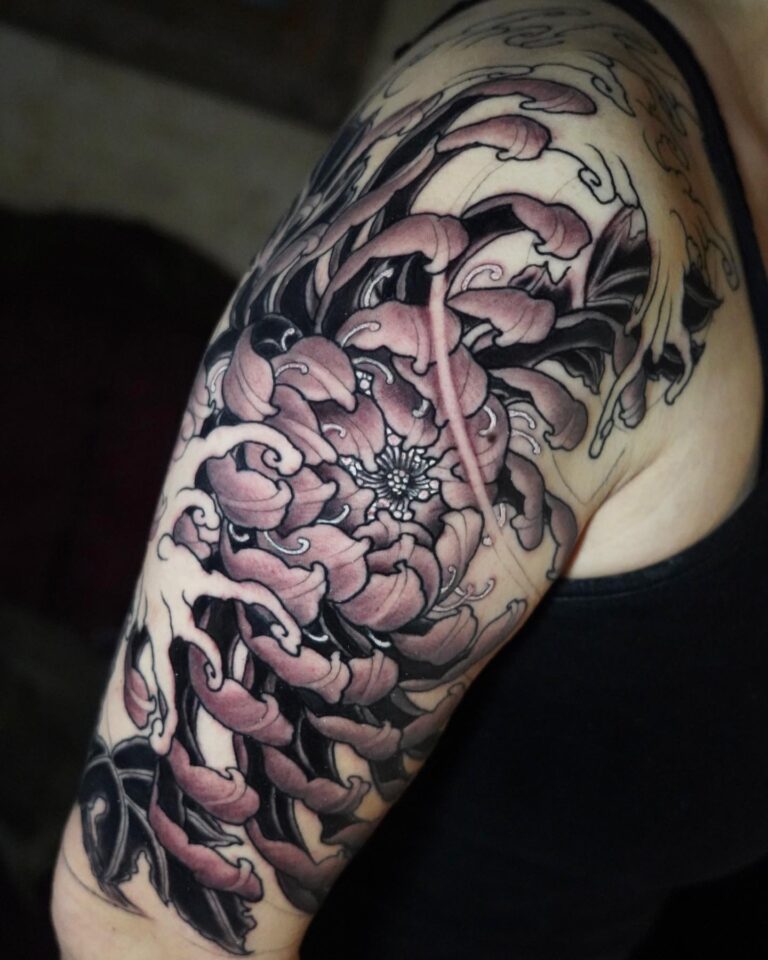
This tattoo often features detailed blossoms with a range of colors and intricate petal designs. It’s perfect for those who appreciate the elegance and symbolism of the chrysanthemum and want to express a sense of renewal and enduring beauty.
Tattoo Aftercare Tips for Japanese Tattoos (400 Words)
Aftercare is crucial for Japanese tattoos because of the intricate detail and bold coloration. Here’s how to ensure your tattoo heals perfectly:
1. Follow Artist Instructions
Your tattoo artist will likely recommend a specific aftercare routine. Whether it includes a healing balm, gentle soap, or bandage type, follow their guidance to avoid infection and ensure proper healing.
2. Initial Healing Phase
In the first 3–5 days, wash your tattoo gently with mild soap and lukewarm water. Pat dry with a clean towel and apply a thin layer of fragrance-free ointment or tattoo balm. Avoid heavy creams that can clog pores.
3. Hydration and Rest
Keep your skin hydrated by drinking water and moisturizing as needed. Rest is important for your body to heal properly, especially after long sessions covering large areas like sleeves or back pieces.
4. Avoid Sun and Water
Sun exposure can fade the vibrant colors typical of Japanese tattoos. Keep the tattoo covered or use high-SPF sunscreen once healed. Avoid swimming or soaking in water for at least two weeks.
5. Don’t Pick Scabs
Scabbing and peeling are part of the process. Let it happen naturally. Picking can remove ink and damage your design.
6. Long-Term Care
Once healed, keep your tattoo looking vibrant by moisturizing regularly and avoiding prolonged sun exposure. Japanese tattoos are designed to last—treat them like the masterpieces they are.
Final Thoughts (250 Words)
Japanese tattoos are timeless expressions of art, culture, and personal meaning. Their roots in history and mythology make them more than just decoration—they’re wearable stories. Whether you’re drawn to the courage of a koi fish, the strength of a tiger, or the beauty of a cherry blossom, Japanese tattoos provide depth, symbolism, and striking visual impact.
From the design stage to final inking, every part of the journey should be intentional. Choose symbols that resonate with your values, find a skilled artist with knowledge of traditional styles, and plan a composition that flows naturally with your body. Respect the cultural heritage behind the art form and approach it with the mindfulness it deserves.
Don’t forget that a tattoo’s longevity relies heavily on proper aftercare. Treat your new ink with the same reverence as the story it tells—because in the end, your tattoo becomes part of who you are.
Whether you’re getting your first Japanese piece or expanding a full body suit, let your tattoo speak boldly and beautifully for years to come.
FAQs About Japanese Tattoo Ideas
1. What is the meaning behind traditional Japanese tattoos?
Traditional Japanese tattoos, known as irezumi, are deeply symbolic and tell stories through their imagery. Each motif carries its own cultural and spiritual significance. For example, the koi fish represents perseverance and strength because of its ability to swim upstream and transform into a dragon. Dragons symbolize wisdom, protection, and power. Cherry blossoms (sakura) remind us of the fleeting nature of life due to their short blooming period. Tigers represent courage and protection against evil spirits. Even masks like the Hannya symbolize complex human emotions such as jealousy and sorrow. The art form is not just decorative—it’s storytelling rooted in Japanese history and mythology. When choosing a Japanese tattoo, understanding the meaning behind each element helps ensure your tattoo resonates personally and respects the cultural heritage.
2. Are Japanese tattoos painful, and where do they hurt the most?
Pain levels for Japanese tattoos depend on placement, size, and your pain tolerance. Since Japanese tattoos often cover large areas like the back, sleeves, or chest, they require multiple sessions and extended time under the needle. Some areas are more sensitive, such as ribs, the inner arm, knees, and armpits, where the skin is thinner and there’s less muscle or fat cushioning. Areas like the outer arm, shoulders, and upper back tend to be less painful. Large-scale Japanese tattoos also require shading and layering of colors, which can add to discomfort. It’s important to communicate with your tattoo artist about breaks and pain management during sessions. Proper mental preparation and aftercare can also ease the healing process.
3. How do I find the right artist for a Japanese tattoo?
Finding the right artist is crucial for Japanese tattoos due to their complexity and cultural significance. Look for an artist who specializes in irezumi or has extensive experience with Japanese-style tattoos. Review portfolios carefully to ensure they can replicate traditional techniques such as bold linework, smooth shading, and flowing compositions. The artist should respect the symbolism and be willing to discuss the meanings behind the designs with you. Additionally, check reviews and ask for recommendations within tattoo communities that appreciate Japanese art. A skilled artist will guide you through the design and placement process, ensuring the tattoo fits your body naturally and tells a cohesive story. Remember, a Japanese tattoo is a long-term commitment, so choose an artist you trust and feel comfortable with.
4. What should I expect during the healing process of a Japanese tattoo?
The healing process for Japanese tattoos is similar to other tattoos but requires particular care due to the large areas and color saturation. Initially, your tattoo will be swollen and tender for a few days. It’s important to keep the area clean by washing gently with mild soap and lukewarm water. Avoid picking at scabs or peeling skin to prevent fading or infection. Applying a thin layer of fragrance-free ointment or tattoo balm helps keep the skin hydrated. Avoid soaking in pools or baths and stay out of direct sunlight until fully healed. Healing usually takes 2-4 weeks, depending on the size and placement. Because Japanese tattoos often feature vibrant colors and fine details, following aftercare instructions strictly helps maintain their clarity and vibrancy for years.